REPORT
DCYF Community Needs Assessment

Department of Children, Youth and their Families (DCYF) Community Needs Assessment
Every 5 years, DCYF engages children, youth, transitional age youth (TAY), parents, and service providers in a Community Needs Assessment (CNA). The CNA aims to determine the services needed to achieve the vision of the Children and Youth Fund. Read the 2022 CNAFor DCYF, our CNA is an opportunity to devote time and energy to:
- Listen to community members
- Understand the strengths and challenges facing San Francisco children, youth, and families
- Lift their voices and amplify their impact
Equity drives our approach. We collect and analyze data to generate findings that help us focus on services that address the needs of our children, youth, and families.
Guiding questions of the CNA
- How are children, youth, TAY, and families faring in San Francisco?
- What groups of children, youth, TAY, and families face significant disparities in opportunities or outcomes?
- What are the service needs of children, youth, TAY, and families in San Francisco? How has COVID-19 changed well-being and service needs?
- What are the services and resources that are available in low-income and disadvantaged communities compared to the services and resources that are available citywide?
- What are existing programs, services, and community assets that enable children, youth, TAY, and families to thrive in the face of everyday adversities? What assets might support communities in recovering from the impacts of COVID-19?
Community engagement
Community engagement for the CNA began in August 2019 and concluded in January 2022. There was a pause between March 2020 and March 2021 due to the COVID-19 pandemic. We spoke directly with children, youth, and families through:
- Focus groups
- Surveys
- Interviews
- Outreach events
For more insight into the findings from our community engagement efforts, please read our community engagement summaries:
Learn more about our 5-year funding cycle planning process
Overview of San Francisco’s Children, Youth & Families
Population trends
13.4% of San Francisco’s population is children and youth under 18. This is one of the smallest percentages of children in a major US city. In 2021, there were an estimated 113,227 youth under 18.
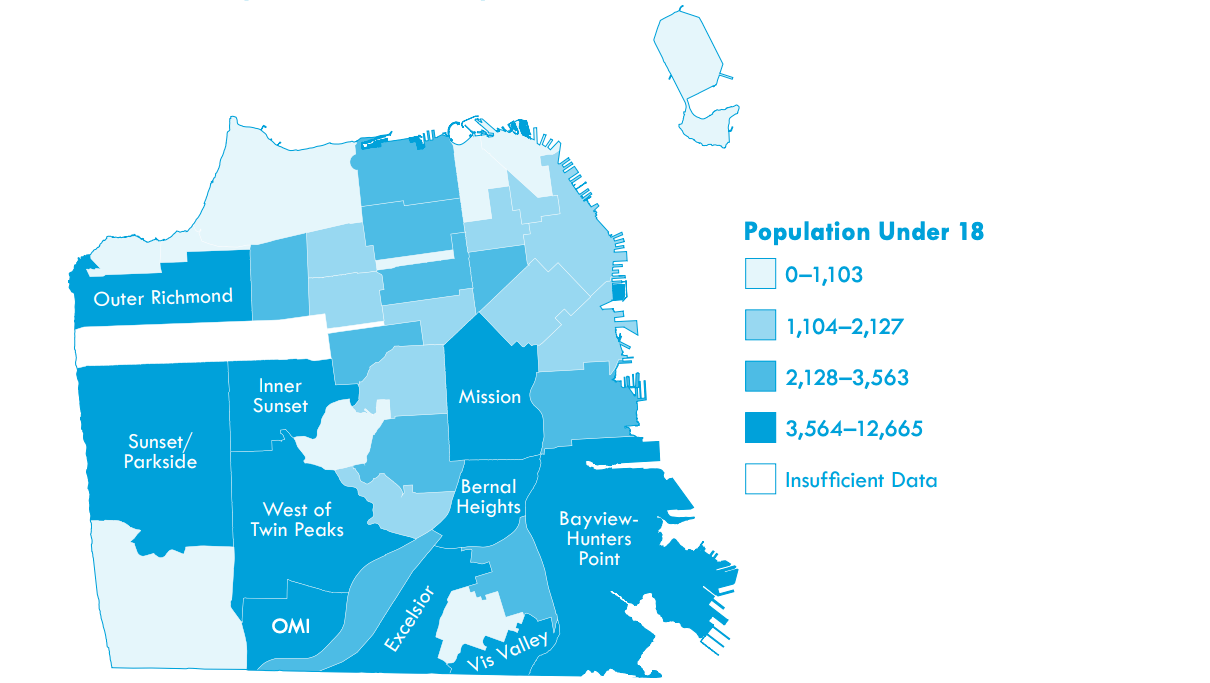
Diverse demographics
African American/Black, American Indian/Alaska Native, and Pacific Islander populations have declined in recent decades. Meanwhile, Multiracial, Asian, and Hispanic/Latinx populations have grown.
Over a third of San Francisco residents are immigrants born out of the country. An estimated 4,600 youth have undocumented immigration status.
The City’s diverse population live in micro-communities emblematic of racial segregation.
Opportunity in San Francisco
Low-income families and youth
30% of youth ages 0-17 (nearly 34,000 youth) in San Francisco were living in families earning below 300% of the Federal Poverty Level (FPL). An extra 17% or 19,000 youth were in families earning below 500% of the FPL.
Children of families living in poverty in San Francisco are more likely to be African American/Black, Hispanic/Latinx, Asian American/Pacific Islander, and American Indian.
Over half of children residing in Treasure Island, Chinatown, Tenderloin, South of Market, Mission, Bayview Hunters-Point, and the Visitacion Valley are living in families earning below 300% of the FPL.
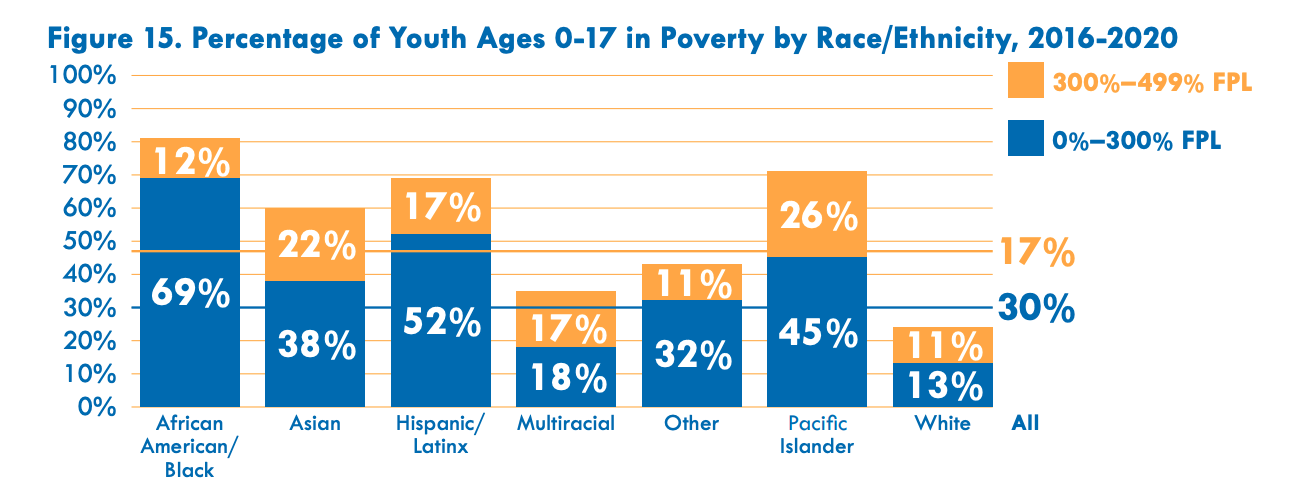
High cost of living
In San Francisco, individuals and families living below 400% and even 500% of the FPL ($109,916 and $137,395 for a family of four) are considered low-income due to the high cost of living.
49% of DCYF parent/caregiver survey respondents felt they were able to manage paying their rent, utility, and bills “just fine.”
Only 42% of DCYF parents/caregivers survey respondents reported having a job that paid enough for their family’s expenses.
Housing stability and homelessness
The 2022 Point in Time (PIT) Count of people experiencing homelessness in San Francisco reported 1,073 unaccompanied children and TAY, and 205 families experiencing homelessness.
“Just trying to balance making an income and being able to afford to live here. Parents are tied up and don’t have time to take advantage of the benefits of living in the city.”
- Parent, CityKids Fair interview
“I’ve never had and don’t have now a space at home to be able to have peace and quiet. My uncle and cousin are using up all the space, causing noise. I need quiet, but it’s hard to stay focused without the right environment.”
- TAY, focus group with TAY experiencing homelessness
Nurturing families and communities
Connections to caring adults
In 2019-20 school year, 54% of 9th grade respondents and 58% of 11th grade respondents expressed they had a caring adult relationship.
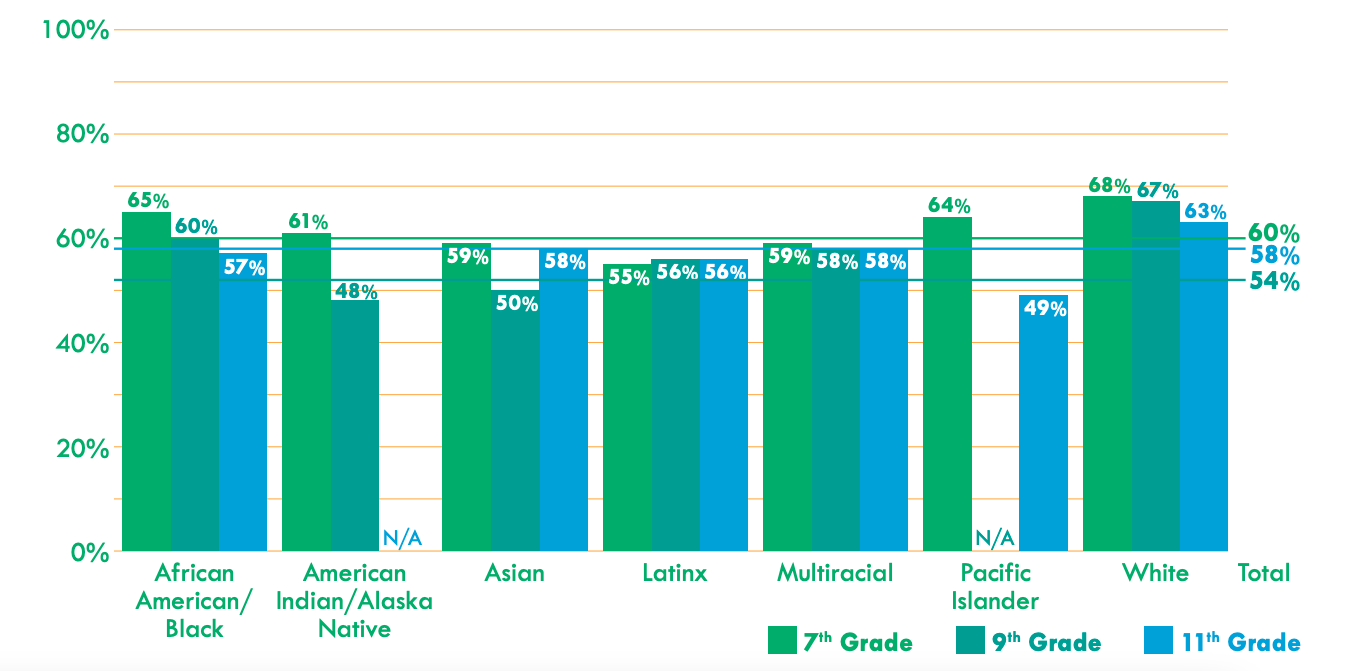
Child safety and family stability
The number of youth up to 21 years old involved in the San Francisco foster system declined to 638 by December 2021. Youth of color and LGBTQQ youth continue to appear in foster systems at disproportionately high rates.
Despite a declining overall rate of youth in the justice system, a disproportionate number of African American/Black and Latinx youth have active probation cases.
Among 673 human trafficking cases reported in 2017, 70% were people of color and 70% were youth and TAY under age 25.
Accessible childcare
Only 45% of DCYF parent/caregiver survey respondents with children under age 5 felt their childcare was affordable.
Safety concerns
46% of DCYF parent/caregiver survey respondents felt safe from violence in their neighborhood. 47% of youth respondents felt safe in their community.
Roughly 24% of reported anti-Asian hate incidents in California in 2021-2022 took place in San Francisco.
“Some of us do not have DACA. It is very hard to access resources, especially when your family is undocumented. It is hard to access help when you don’t have certain paperwork. There is a tiered level of ability to get resources, even amongst undocumented people.”
- Young person, focus group with undocumented and immigrant community
“Childcare is a big need. We’re in the middle ground, don’t qualify and still not affordable. We don’t have extra family to help, so it’s hard.”
- Parent, CityKids Fair Interview
“I don’t want to target neighborhoods specifically as unsafe, but places where people are using substances, have mental health needs, more support needed. I don’t feel safe walking through there, and people are needing help that we’re not able to all provide.”
- Parent, focus group with American Indian families
Physical and emotional health
Health disparities
African American/Black mothers have a preterm birth rate of 16% compared to a citywide rate of 8%.
In the 2018-19 school year, African American/Black, American Indian/Alaska Native, Filipino, Hispanic/Latinx, and economically disadvantaged SFUSD students demonstrated much lower rates of aerobic capacity compared to their Asian and White peers.
12 of every 100,000 African American/Black 10 to 24 year-olds died by suicide in 2020. The rate has doubled since 2014 and is now twice the statewide average.
Research shows that Asian adolescents generally have higher rates of unmet mental health needs. They are at greater risk for depression, anxiety, self-injury, and suicide than African American/Black or White youth.
Food insecurity
During the COVID-19 pandemic, the number of San Francisco residents on CalFresh increased by 40%. (San Francisco Food Security Task Force, 2022 Recommendations)
A survey by the SF Marin Food Bank showed that households with children, especially single-parent households, had the highest rates of food insecurity among their clients.
Mental health and wellness
The 2019 Youth Risk Behavior Survey (YRBS) suggests that mental health services are needed for approximately one-third of adolescents in San Francisco.
Data from the 2017-2019 YRBS show 43% of SFUSD students who identified as bisexual considered suicide and 18% attempted suicide, significantly more than heterosexual-identifying students (11% and 6% respectively).
48% of surveyed TAY experiencing homelessness suffered from a psychiatric or emotional condition, and 43% suffered from post-traumatic stress disorder. (Department of Homelessness and Supportive Housing, 2019 PIT Count)
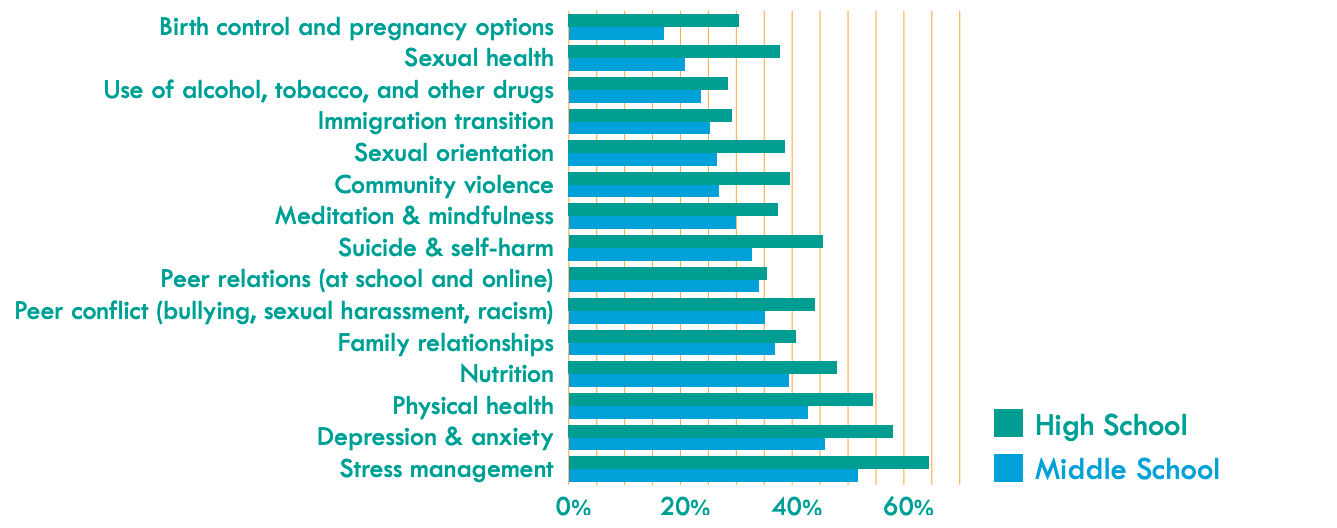
“I know a lot of people who want to go to Kaiser, for example, for mental health services, but they’re swamped, they’re overloaded. There’s a lot of teens. I’m a high school counselor, and there’s a lot of teens that need access, and school resources are very limited until they try to go to Kaiser, and to no fault of their own, they just don’t have all the support services that they need.”
- Parent, Pop-Up Village interview
“Support for anxiety and depression, that should be across the board for the kids. My granddaughter, the middle one, for some reason, she’s having anxiety. I don’t know why, or when it started, she likes to stay isolated for some reason.”
- Parent/caregiver, Focus group with African American/Black families
Readiness to learn and succeed in school
K-12 enrollment
SFUSD K-12 enrollment declined by 7% from the 2019-20 school year to the 2021-22 school year. White and Filipino enrollment declined by 14%. American Indian student enrollment declined by 21% between the 2019-20 and 2021-22 school years.
School experiences
Between 2017-2019, only 30% of African American/Black youth expressed feeling a high level of school connectedness.
Between 2017 and 2019, 42% of surveyed LGBTQQ students in SFUSD reported being bullied at least once in the previous year, compared to 27% of their straight peers.
75% of students who receive school suspensions are socioeconomically disadvantaged.
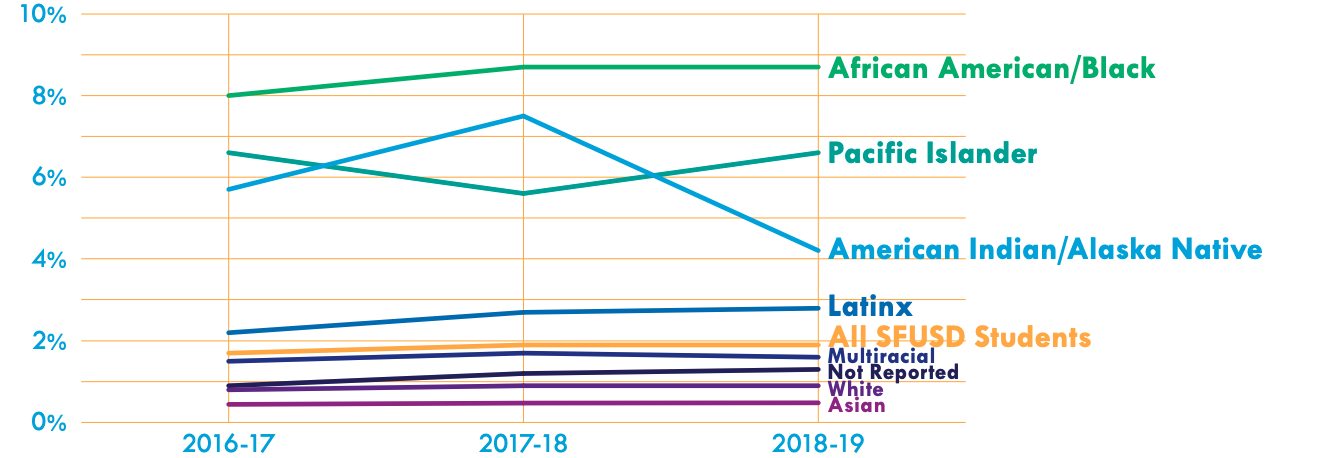
Academic performance
High schoolers make up the majority (63%) of students who are chronically absent. Rates of chronic absences among foster youth, youth experiencing homelessness, and students with disabilities are significantly higher than average.
Academic proficiency in Reading/English, Language Arts and Math are disproportionately below average among African American/Black, American Indian, Latinx, and Pacific Islander students. Rates of academic proficiency are particularly low for students experiencing low socioeconomic status, housing instability, and foster system involvement.
“The life of being a public school parent or educator is that we are always trying to make the best of underfunded schools but I feel like we can go too far to the point where it’s gaslighting to try and paint things that are cuts as opportunities. I would like us to be very frank for the benefit of our city about what the costs of these cuts are. We are a city with 75 billionaires—the most dense in the world. I’m really concerned when we talk about shifting staff...because every time that happens school sites that don’t have large PTAs end up experiencing cuts in real time.”
- SFUSD Parent, November 2 School Board Meeting
“They need more staff at school for children’s safety. A lot of behavioral issues at school and teachers don’t say anything.”
- Parent, focus group with Mayan families
“They need interpersonal and social emotional guidance on how to deal with kids again and navigating friendly play and disagreements. They need extra reading and writing support because that was ineffective online. They need reading comprehension and writing planning and editing skills.”
- Parent, Summer Together Survey
“[Our family’s greatest need is] financial assistance for potential After School programs. Worried can’t afford this fall and not sure what to do with my 6th grader considering school starts so late (9:30) and gets out before I may be able to pick him up.”
- Parent, Summer Together Survey
“We want kids with disability to be able to go to any camp they want to. The city needs to provide the staffing and hiring and training so this is possible.”
- Parent, CityKids Fair interview
Readiness for college, work, and productive adulthood
High school graduation
58.1% of San Francisco residents who are 25 years or older have a bachelor’s degree, compared to 34.7% in California and 32.9% nationally.
Postsecondary education enrollment and completion
The average four year graduation rate for SFUSD high school graduates was 88% in the 2020-21 school year, with lower rates reported among students who are American Indian/Alaska Native, Hispanic/Latinx, Pacific Islander, and African American/Black.
In the 2020-21 school year, the five year graduation rate for foster youth was 64.5%. When youth are supported by a court-appointed educational rights holder, graduation rates have been shown to increase to between 80% and 90%.
In the 2020-21 school year, less than half of African American/Black (42%), Pacific Islander (43%), and Hispanic/Latinx (51%) SFUSD graduates met UC/CSU requirements.
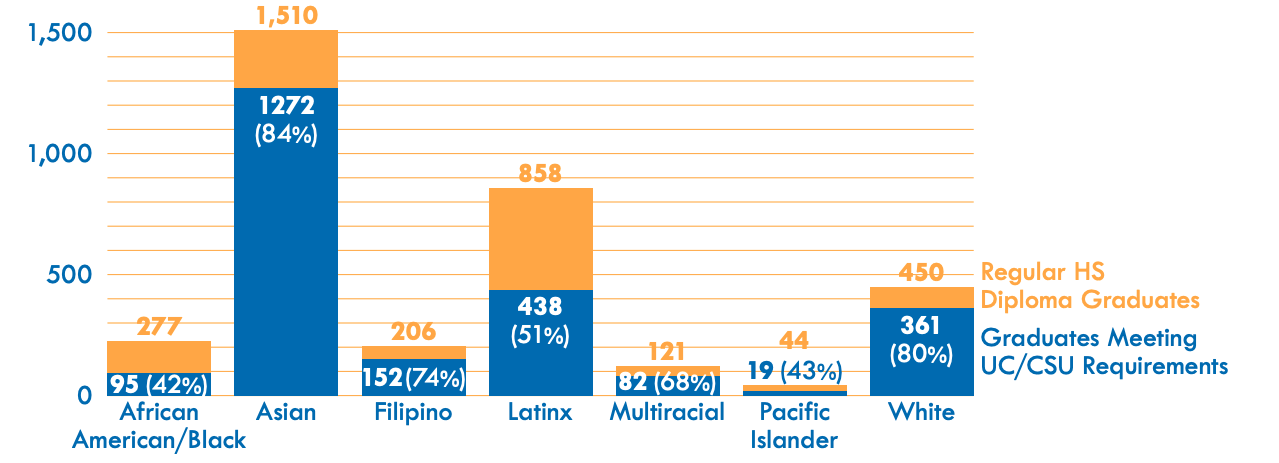
Youth workforce development
More than 80% of SFUSD high school students surveyed by DCYF in 2021 reported an interest in jobs and internships.
Only 43% of DCYF parent/caregiver survey respondents agreed that they had access to job training for their TAY-aged child.
65% of SFUSD high school students surveyed by DCYF in 2021 expressed interest in career preparation programs/activities.
Next step: DCYF Services Allocation Plan (SAP)
The CNA is the first step in DCYF’s planning cycle. The data highlighted here guides DCYF's next planning step: our Services Allocation Plan (SAP). The SAP describes how Children and Youth Fund dollars will be allocated for the 2024-29 funding cycle.
During the SAP development process, DCYF examines how well priority populations are being reached and service needs are being met through existing investments and partnerships.
Our process centers the data and findings from the CNA to ensure that our allocations address the needs and disparities highlighted in this report.
CNA resources
Community needs assessment plan 2019-2021